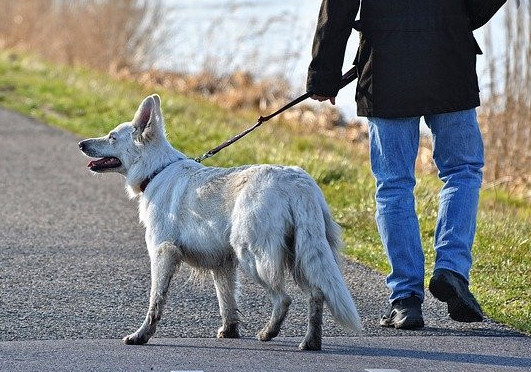Your dog used to be an avid walker, it was the highlight of their day. Just the sound of the leash or collar and your best friend would come sprinting towards you. Jumping up and down in extreme excitement as you try your best to put the collar on and then they fly towards the front door.
Once outside, the roaming begins. Smelling here and sniffing there, relieving themselves at will whenever they have the urge, a nice long active walk for your four-legged friend is usually the highlight of any day.
But what has happened if one day you wake up and suddenly realize that my dog doesn’t want to walk anymore? Are they sick, have they become frightened of something that they wouldn’t bat an eyelid at before, maybe an injury or illness, there are many reasons why your pal suddenly doesn’t want to venture outside anymore, but what are they and how can we rectify the situation?
At perfectpuppypal.com, we are not qualified veterinarians or animal nutritionists. The information that we provide is general and educational information only and is not a substitute for professional advice.
Fearfulness
Your pup may have had a very bad experience or two on a recent walk, and for them, this could well be why they are reluctant to venture outside again even if they had no problem when going out before.
What could cause this you are asking, well there are many reasons why Fido could be a little afraid to go out into the great outdoors again. Their ears are a lot more sensitive than ours and certain sounds have a way of affecting them a lot more than they do for us.
For instance, a police siren, ambulance, or firetruck screaming past may be irritating to us but for our four-legged friends, this noise has the capacity to really upset them.
Other more innocent sounds such as a child screaming somewhere or even one whizzing past on a scooter could also have an effect on our dog’s brain preventing them from wanting to take part in what used to be their favourite outdoor activity.
Who would want to go out and experience the one thing that has left us so scared before and repeat the experience, not many of us I’m sure, so why do we have to put our four-legged friends through this ordeal?
Depending on where the noise was heard on a previous walk it could make them very wary to want to walk past or even near the spot they heard it before again.
Injury
Dogs don’t speak so it is sometimes difficult to know if they have picked up an injury here or there which will prevent them from joining you on what would normally be a favoured long trek into the great outdoors together.

If they have an injury that is obviously causing them distress then it’s easy to pick up on but minor problems such as an injury to a paw or smaller problem are more difficult to detect, so if you believe this could be the issue check your pup over thoroughly or visit your local vet for confirmation.
Your vet should be able to tell if the injury is nothing to really worry about, and is minor enough to be resolved by itself within a few days or if it happens to be something a bit more serious which then would need further treatment.
Underlying health issues
Your pal could have an underlying health problem that prevents them from walking as they would normally. There are various types of underlying health issues that your dog could be suffering from that prevents them from wanting to venture outside as they once did.
These issues include a possible infection, kidney or liver disease, respiratory issues, heart disease, kidney or bladder stones, or possibly the side effects of any new medication which your dog may be taking.
If unsure, then it’s always best to have your canine companion checked out with your vet in order to rule out any of the above conditions. Or, if one is detected then treatment can be given as soon as possible.
Age
Of course, your dog’s age can have a lot to say about how much they are able to walk, and obviously, the older your four-legged friend becomes, then they are not as able to run around and be as active as they used to be as a pup.
But if they suddenly don’t feel the urge to venture out anymore at all, then it is better to get your vet to give them a thorough once over as you never know what could happen next.
As dogs age, the chance of them developing health issues or contracting an illness increases, just like it does for us. So if their behavior has suddenly changed for no apparent reason as your pal enters the latter stages of life then my recommendation would be to seek a vet’s assistance at the earliest opportunity.
At the end of the day, no one knows your favourite furry friend better than you do
So, what to do if my dog doesn’t want to walk anymore?
The first thing you have to do if your canine companions’ behavior or habits have changed drastically in regards to wanting to take a stroll outside with you is to get them checked out at the vet.
If everything is fine with their physical health and no problems or injuries have been detected then it is most likely a mental issue.
In this case, it is very important to have patience. Taking things one small step at a time is imperative. If your pal has been scared in any way whilst being outside then the worst thing you can do is force the situation which to begin with could make matters a whole lot worse.
Take your time and please have patience, there is nothing worse for your canine companion than repeatedly having to feel this fear over and over again.
Take them out in little steps when trying to get them used to the great outdoors again. This is certainly not a mean feat to achieve, but try your best to follow the guidelines below and you will not go far wrong.
These guidelines are what you ask? Well to start with, it’s always best to start slowly, each dog is different and can respond to training in a different way, the most important thing is not to push it or pressurize your furry friend in any way. Take it one small step at a time, as if you were training your puppy for their first trek into the unknown.
Try your best to make putting on the leash a game and reward with lots of treats as you manage to entice them towards the front door. Open the door and wait a bit to see what their reaction is.
If there are no obvious signs that leaving the comfort of home is imminent then let them back in, remove the leash and wait for 20-30 mins and then repeat the procedure.
When you finally get outside the front door and your best pal seems a little more comfortable with their surroundings keep them entertained and encouraged by offering their favourite tasty snacks for every small milestone that they reach. If they don’t wish to venture further then never try to force them and return back home as they wish.
Hopefully, after following these guidelines and tips, taking your beloved pet out for long walks will become an enjoyable experience for you both again.
As always at perfectpuppypal.com we are grateful for any comments you may have or any experiences where you had an avid walker before, but now things have changed and what you did to rectify the situation.
